K-class: Difference between revisions
Pbcjohnston (talk | contribs) (Finished formatting and design notes) |
Pbcjohnston (talk | contribs) |
||
| (14 intermediate revisions by the same user not shown) | |||
| Line 2: | Line 2: | ||
=== <big>Design, Construction, and Naming Notes</big> === | === <big>Design, Construction, and Naming Notes</big> === | ||
<div style="text-align: justify;"><span style="color:#00008B">The K-class coastal defense submarines were authorized in Fiscal Year 1911. Predictably, they were slightly larger versions of the preceding H-class, about three feet longer, one foot wider, and about 40 tons heavier on the surface. The armament stayed the same at four 18" bow torpedo tubes. These EB design boats were built at three different yards: K-1, K-2, K-5, and K-6 at Fore River Shipbuilding in Quincy, MA., K-3, K-7, and K-8 at Union Iron Works in San Francisco, and K-4 at Moran | <div style="text-align: justify;"><span style="color:#00008B">The K-class coastal defense submarines were authorized in Fiscal Year 1911. Predictably, they were slightly larger versions of the preceding H-class, about three feet longer, one foot wider, and about 40 tons heavier on the surface. The armament stayed the same at four 18" bow torpedo tubes. Unusually, Electric Boat eliminated the bulkheads that made the control room a separate space, reverting back to the concept of having the forward battery, control room, and after battery one large space. The reason for this change is not clear; at any rate this was the last class of submarines in the USN without a separate control room. These EB design boats were built at three different yards: K-1, K-2, K-5, and K-6 at Fore River Shipbuilding in Quincy, MA., K-3, K-7, and K-8 at Union Iron Works in San Francisco, and K-4 at the Moran Company in Seattle. There is some debate about which organization actually built the K-4. The Moran Company in Seattle was going through significant organizational changes during this period, and came out of this process called the Seattle Construction & Dry Dock Company. It is likely that the construction contract was signed by Moran Company representatives, but the actual construction was handled by SC&DD. | ||
Although considered successful boats, the vastly changed naval environment and the emphasis on fleet submarines after WWI made these coastal patrol boats quickly obsolete. They were all decommissioned and discarded in the early 1920's, after only about nine years of service.</span> | |||
[[File:Red bar sub new.jpg]] | [[File:Red bar sub new.jpg]] | ||
<div style="text-align: justify;"><span style="color:#000000"> | |||
=== <big>K-1 (Submarine No. 32, later SS-32)</big> === | === <big>K-1 (Submarine No. 32, later SS-32)</big> === | ||
[[File: | [[File:K-1 at Horta.jpg|left|500px|Photo in the private collection of Ric Hedman.]] | ||
<div style="text-align: justify;"><span style="color:#00008B"> | <div style="text-align: justify;"><span style="color:#00008B">K-1 shortly after her arrival at Horta, Faial, in the Azores in late October 1917. The submarine had yet to have the chariot bridge installed. The pipe and canvas bridge structures used in the peacetime waters off the U.S. proved to be utterly impracticable in a wartime setting, so following the European lead the permanent steel chariot bridge structures were later added. We would like to pass on our thanks to Mike Amaral for providing us with a correction to the location of the photo.</span> | ||
[[K-1|See more K-1 photos]] | [[K-1|See more K-1 photos]] | ||
| Line 14: | Line 19: | ||
=== <big>K-2 (Submarine No. 33, later SS-33)</big> === | === <big>K-2 (Submarine No. 33, later SS-33)</big> === | ||
[[File]] | [[File:K-2 azores.jpg|left|500px|Photo in the private collection of Ric Hedman.]] | ||
<div style="text-align: justify;"><span style="color:#00008B"> | <div style="text-align: justify;"><span style="color:#00008B">K-2 leaving port at her base in Ponta Delgada, Azores, early 1918. Her bow diving planes are rigged out, somewhat unusual if she was to make an extended surface run. She may be headed out for a local dive to test repairs. At any rate, K-2 was the first USN submarine to make a war patrol in European waters.</span> | ||
[[K-2|See more K-2 photos]] | [[K-2|See more K-2 photos]] | ||
| Line 22: | Line 27: | ||
=== <big>K-3 (Submarine No. 34, later SS-34)</big> === | === <big>K-3 (Submarine No. 34, later SS-34)</big> === | ||
[[File]] | |||
<div style="text-align: justify;"><span style="color:#00008B"> | [[File:K-3 on trials.jpg|left|500px|Photo 45513805 via the National Archives.]] | ||
<div style="text-align: justify;"><span style="color:#00008B">K-3 is shown here on her builder's trials, September 1914, possibly in or near San Francisco Bay. Note the two civilians on her forward deck. These would be yard workers from the Union Iron Works yard that built her. | |||
Note the vertical number "24" on the side of the periscope shears. This is not her hull number. It was an identifier used to determine the boat's place in a steaming formation at sea, i.e. she was the fourth boat of division 2. | |||
Her periscopes are fixed in height and do not retract. The eyepiece down in the control room does not move either. It is fixed in place and the operator cranks a handwheel to rotate the head on top with the lens.</span> | |||
[[K-3|See more K-3 photos]] | [[K-3|See more K-3 photos]] | ||
[[File:Red bar sub new.jpg]] | [[File:Red bar sub new.jpg]] | ||
<div style="text-align: justify;"><span style="color:#000000"> | |||
=== <big>K-4 (Submarine No. 35, later SS-35)</big> === | === <big>K-4 (Submarine No. 35, later SS-35)</big> === | ||
[[File]] | </div> | ||
<div style="text-align: justify;"><span style="color:#00008B"> | |||
[[File:K-4 Bremerton.jpg|left|500px|Photo from the Vallejo Naval & Historical Museum via Mr. Darryl Baker]] | |||
<div style="text-align: justify;"><span style="color:#00008B">This picture is most likely taken on Sinclair Inlet near the Puget Sound Navy Yard circa early 1914 showing the submarine K-4 enroute back to Seattle. At this time there were no marine fueling stations in Seattle dispensing diesel oil. On closer examination a commissioning pennant can not be seen so this is probably prior to her commissioning on October 24, 1914. | |||
The two ships in the background are the receiving ship USS Philadelphia (rear) and the Charleston (Cruiser No. 22). The Philadelphia was serving as a prison ship and had wooden structures built on her decks to accommodate extra berthing for personnel and offices for administrative purposes. | |||
If you look at the Charleston's funnels and number from left to right, between the 3rd and 4th funnel you can see the flag staff with flag flying from the stern of the Philadelphia. | |||
Charleston had been placed in commission in reserve September 14, 1912, she joined the Pacific Reserve Fleet, remaining at Puget Sound (Bremerton) Navy Yard as a receiving ship through early 1916, aside from a voyage to San Francisco in October 1913 as flagship for the Commander-in-Chief, Pacific Reserve Fleet. From 1912 through early 1916, she was receiving ship at the yard.</span> | |||
[[K-4|See more K-4 photos]] | [[K-4|See more K-4 photos]] | ||
[[File:Red bar sub new.jpg]] | [[File:Red bar sub new.jpg]] | ||
<div style="text-align: justify;"><span style="color:#000000"> | |||
=== <big>K-5 (Submarine No. 36, later SS-36)</big> === | === <big>K-5 (Submarine No. 36, later SS-36)</big> === | ||
[[File]] | </div> | ||
<div style="text-align: justify;"><span style="color:#00008B"> | [[File:K-5 near Norfolk.jpeg|left|500px|Photo NH 52376 courtesy of NHHC.]] | ||
<div style="text-align: justify;"><span style="color:#00008B">K-5 underway in the approaches to Norfolk, VA., near Thimble Shoals Light, December 13, 1916. The city of Hampton is in the background, Buckroe Beach is visible. The boat has probably returned from a submerged run and the crew has not taken the time to erect the pipe frame and canvas bridge structure.</span> | |||
[[K-5|See more K-5 photos]] | [[K-5|See more K-5 photos]] | ||
[[File:Red bar sub new.jpg]] | [[File:Red bar sub new.jpg]] | ||
<div style="text-align: justify;"><span style="color:#000000"> | |||
=== <big>K-6 (Submarine No. 37, later SS-37)</big> === | === <big>K-6 (Submarine No. 37, later SS-37)</big> === | ||
[[File]] | </div> | ||
<div style="text-align: justify;"><span style="color:#00008B"> | [[File:K-6 underway-1.jpg|left|500px|Photo in the private collection of Ric Hedman.]] | ||
<div style="text-align: justify;"><span style="color:#00008B">K-6 photographed circa 1914-1915. The date may be summer 1914 based on the fact the man on deck is in shirt sleeves. The long, low background appears to be the Cape Cod peninsula near Provincetown, MA. A number of crew are seen on the bridge and one person on deck. The boat appears to be flying a Squadron flag from a "pig stick" atop her #2 periscope and some sort of signal flag from her port flag hoist.</span> | |||
[[K-6|See more K-6 photos]] | [[K-6|See more K-6 photos]] | ||
[[File:Red bar sub new.jpg]] | [[File:Red bar sub new.jpg]] | ||
<div style="text-align: justify;"><span style="color:#000000"> | |||
=== <big>K-7 (Submarine No. 38, later SS-38)</big> === | === <big>K-7 (Submarine No. 38, later SS-38)</big> === | ||
[[File]] | </div> | ||
<div style="text-align: justify;"><span style="color:#00008B"> | |||
[[File:K-7 trials.jpg|left|500px|Photo NH 52396 courtesy of NHHC.]] | |||
<div style="text-align: justify;"><span style="color:#00008B">K-7 underway on builder's trials near San Francisco, October 3, 1914. She is likely running at her full speed of 14 knots judging by the bow wave. She has not yet been commissioned and is under control by Union Iron Works personnel, with a few of her Navy crew along as observers. The local U.S. Navy Supervisor of Shipbuilding office would also have a naval constructor onboard to verify the test met specifications.</span> | |||
[[K-7|See more K-7 photos]] | [[K-7|See more K-7 photos]] | ||
[[File:Red bar sub new.jpg]] | [[File:Red bar sub new.jpg]] | ||
<div style="text-align: justify;"><span style="color:#000000"> | |||
=== <big>K-8 (Submarine No. 39, later SS-39)</big> === | === <big>K-8 (Submarine No. 39, later SS-39)</big> === | ||
[[File]] | </div> | ||
<div style="text-align: justify;"><span style="color:#00008B"> | |||
[[File:K-8 wash day.jpg|left|500px|Photo in the private collection of Ric Hedman.]] | |||
<div style="text-align: justify;"><span style="color:#00008B">K-8 at the fleet anchorage at Lahaina Roads on Maui, Territory of Hawaii, circa 1916. The crew is in the midst of washing clothing and generally relaxing. A crude diving board has beenmade from the gangplank. The shadow can be seen running diagonally on the hull in front of the conning tower. A crewman is running out the plank to dive in the warm waters. | |||
In the background is the island of Maui. The submarine division numbers are on the side of the periscope shears and they are a "3" over a "4" making the K-8 part of Submarine Division 3 and in the 4th position within the division. | |||
Thanks to Tracy White for the location identification.</span> | |||
[[K-8|See more K-8 photos]] | [[K-8|See more K-8 photos]] | ||
| Line 69: | Line 107: | ||
[[File:Red bar sub new.jpg]] | [[File:Red bar sub new.jpg]] | ||
=== <big>General K-class photos</big> === | <div style="text-align: justify;"><span style="color:#000000"> | ||
[[File]] | |||
<div style="text-align: justify;"><span style="color:#00008B"> | === <big>General K-class & group photos</big> === | ||
</div> | |||
[[File:All8k.jpg|left|500px|Photo from the Rick Larson Collection.]] | |||
<div style="text-align: justify;"><span style="color:#00008B">All 8 K-class submarines moored together, probably November or December, 1918, in a large nest. There is a host of ships in the background, including a destroyer on the right, and a battleship in the middle. With this many ships the location is most likely the Philadelphia Navy Yard. The K-5 is being painted so its numbers aren't shown. Prior to WW I U.S. subs used a temporary pipe and canvas bridge structure that was taken down each time the boat dived. Once the boats reached the WW I operating areas this was proved to be very impracticable and was replaced by a permanent sheet-metal "chariot bridge" favored by the European submarines in the rough North Atlantic waters. Note that none of the K-class was equipped with a deck gun. They were too small for such an installation, even for the diminutive 3"/23 caliber guns used on the L-class.</span> | |||
[[General K-class photos|See more General K-class photos]] | [[General K-class photos|See more General K-class & group photos]] | ||
[[File:Red bar sub new.jpg]] | [[File:Red bar sub new.jpg]] | ||
<center>[[Submarine Classes|Return to the Submarine Classes page]]</center> | |||
[[File:Red bar sub.jpg]] | |||
<center> | <center> | ||
<span style="color:#00008B"> | <span style="color:#00008B"> | ||
Latest revision as of 17:06, 9 November 2023
Design, Construction, and Naming Notes
Although considered successful boats, the vastly changed naval environment and the emphasis on fleet submarines after WWI made these coastal patrol boats quickly obsolete. They were all decommissioned and discarded in the early 1920's, after only about nine years of service.
K-1 (Submarine No. 32, later SS-32)
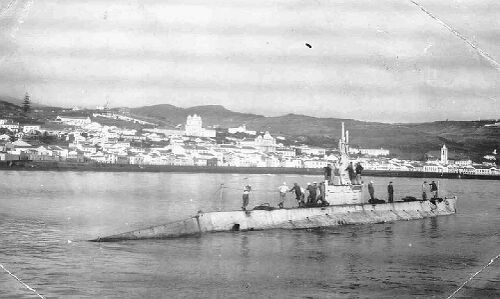
K-2 (Submarine No. 33, later SS-33)
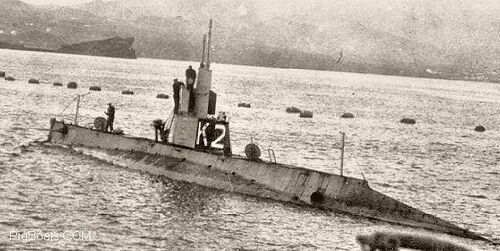
K-3 (Submarine No. 34, later SS-34)
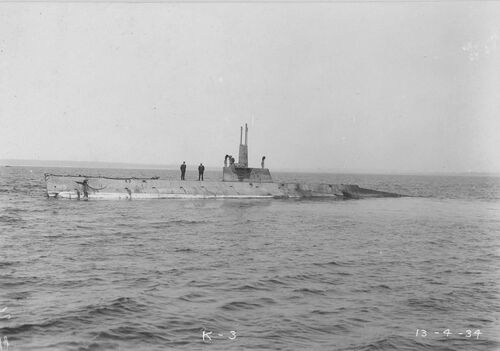
Note the vertical number "24" on the side of the periscope shears. This is not her hull number. It was an identifier used to determine the boat's place in a steaming formation at sea, i.e. she was the fourth boat of division 2.
Her periscopes are fixed in height and do not retract. The eyepiece down in the control room does not move either. It is fixed in place and the operator cranks a handwheel to rotate the head on top with the lens.
K-4 (Submarine No. 35, later SS-35)
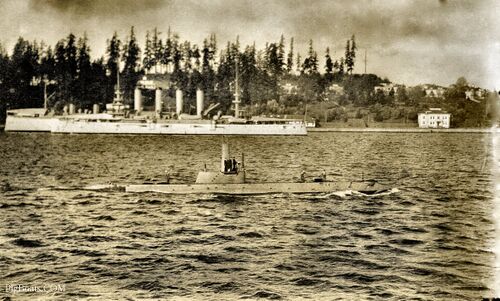
The two ships in the background are the receiving ship USS Philadelphia (rear) and the Charleston (Cruiser No. 22). The Philadelphia was serving as a prison ship and had wooden structures built on her decks to accommodate extra berthing for personnel and offices for administrative purposes.
If you look at the Charleston's funnels and number from left to right, between the 3rd and 4th funnel you can see the flag staff with flag flying from the stern of the Philadelphia.
Charleston had been placed in commission in reserve September 14, 1912, she joined the Pacific Reserve Fleet, remaining at Puget Sound (Bremerton) Navy Yard as a receiving ship through early 1916, aside from a voyage to San Francisco in October 1913 as flagship for the Commander-in-Chief, Pacific Reserve Fleet. From 1912 through early 1916, she was receiving ship at the yard.
K-5 (Submarine No. 36, later SS-36)
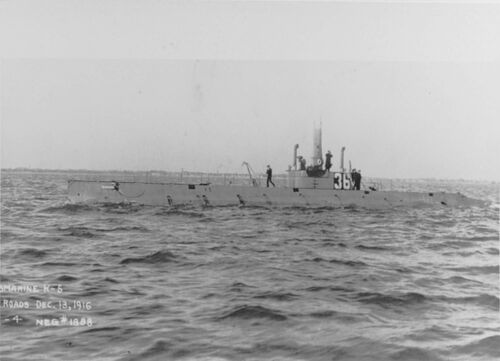
K-6 (Submarine No. 37, later SS-37)
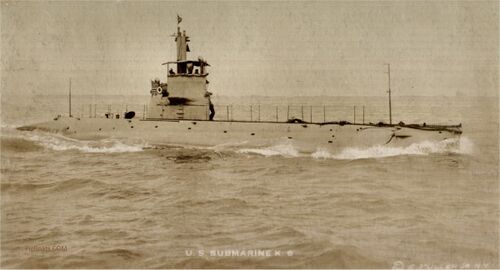
K-7 (Submarine No. 38, later SS-38)
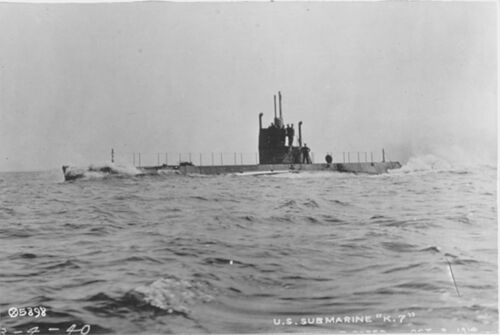
K-8 (Submarine No. 39, later SS-39)
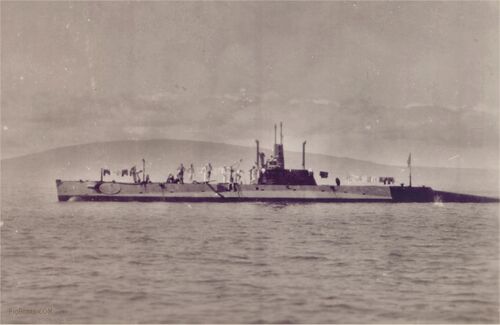
In the background is the island of Maui. The submarine division numbers are on the side of the periscope shears and they are a "3" over a "4" making the K-8 part of Submarine Division 3 and in the 4th position within the division.
Thanks to Tracy White for the location identification.
General K-class & group photos
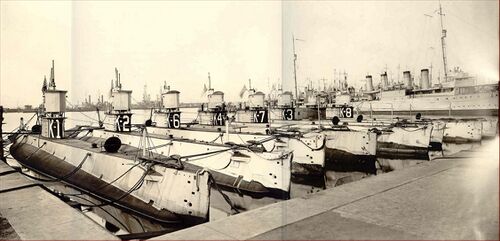
See more General K-class & group photos
Page created by:
Ric Hedman & David Johnston
1999 - 2023 - PigBoats.COM©
Mountlake Terrace, WA, Norfolk, VA
webmaster at pigboats dot com
